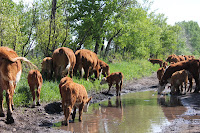Today I had the pleasure of going to the St. A's school, in Ponoka, to discuss, with Mrs. Hackett's grade 6 class, about agriculture! I was a little nervous in the beginning not sure how the class would react to my presentation, hoping they would be very involved in answering and asking questions. Thanks to my luck, I had nothing to worry about! They paid attention, were very interactive, and made it easy for me to present to them.

 Upon entering the classroom I presented the class with a ice cream treat for a token of appreciation for letting me come and speak to them. I started off by asking some simple questions about them, such as: "How many students live in town and how many on a farm". Most of the class of 26 students, had their hands up for living in town; but, only 3 girls lived on a farm. I presented a few statistic's about the percentage of Canadians that live in rural and urban areas. Next I asked someone to tell me there favorite food which happened to be pizza. We talked about the different agricultural products that were used to make it. At this time I wasn't to sure what to expect with their knowledge about agriculture but I underestimated them. They knew that certain types of meat were needed, we needed dairy from cows for the cheese, wheat for the dough, and tomatoes for the sauce. We than discussed if these products were produced in Alberta and they decided that some would be, depending on the pizza, but food like pineapple would have to be imported.
Upon entering the classroom I presented the class with a ice cream treat for a token of appreciation for letting me come and speak to them. I started off by asking some simple questions about them, such as: "How many students live in town and how many on a farm". Most of the class of 26 students, had their hands up for living in town; but, only 3 girls lived on a farm. I presented a few statistic's about the percentage of Canadians that live in rural and urban areas. Next I asked someone to tell me there favorite food which happened to be pizza. We talked about the different agricultural products that were used to make it. At this time I wasn't to sure what to expect with their knowledge about agriculture but I underestimated them. They knew that certain types of meat were needed, we needed dairy from cows for the cheese, wheat for the dough, and tomatoes for the sauce. We than discussed if these products were produced in Alberta and they decided that some would be, depending on the pizza, but food like pineapple would have to be imported. We first talked about beef cattle and even Mrs. Hackett got involved asking if beef quality varies depending on the breed of cattle; which it does - some cows will have genetics for a higher marbling or grade on there meat. I asked them some general questions on beef cattle like: "When are cattle ready to be sold to market?". One of the girls in the class answered 5 years; however, I cleared up the answer for her which was 1 - 1 and a half years. We talked about other products (other than meat) that come from cattle. They were all very surprised to see that the ice cream they had just eaten had gelatin in it, which is made from cows bones and horns. I explained to the class how a heifer is a female who has not had a calf, a bull is a male, and a cow is a female that has had a calf.
 Next we talked about pigs and just like the cows I explained the different terminology for them. They were pretty surprised to find out that pigs can learn tricks faster than dogs and can learn to respond to a name in 2 to 3 weeks after birth. Sheep came next in my presentation. I explained to them how sheep are timid, easily frightened animals who like to stay together and how their only means of survival is to flock together in large numbers and run. The class was a little grossed out when I informed them about the sheep intestine being used for hot dog and sausage casings, as well as, the bones and horns being used to make the gelatin in jello.
Next we talked about pigs and just like the cows I explained the different terminology for them. They were pretty surprised to find out that pigs can learn tricks faster than dogs and can learn to respond to a name in 2 to 3 weeks after birth. Sheep came next in my presentation. I explained to them how sheep are timid, easily frightened animals who like to stay together and how their only means of survival is to flock together in large numbers and run. The class was a little grossed out when I informed them about the sheep intestine being used for hot dog and sausage casings, as well as, the bones and horns being used to make the gelatin in jello. Dairy Cattle came next on the PowerPoint and yes the class did know that chocolate milk doesn't come from brown cows! They didn't know that a cow has to have a calf in order to produce milk and that it is taken away around 3 days after birth.
This was such an amazing class! I really enjoyed going and presenting to the interactive class and would go back anytime. This really shows the agricultural industry that kids are interested in agriculture and like learning about it!
Thank you Mrs. Hacketts Class - You were an inspiration to me!
Watch out for my next "In the Classroom" informing our youth about agriculture!
~Carling
Educating Youth in Ag The Powerpoint I created to present in class.
View more presentations from redhotcowgirlboots


































